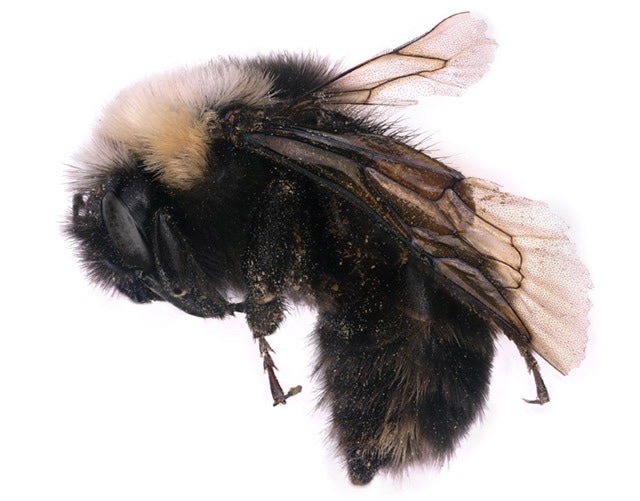The USDA Agricultural Research Service is directing the “Beenome100” project, which aims to create high-quality maps of the genomes of at least 100 bee species, encompassing the variety of bees in the United States and portraying each of the country’s major bee taxonomic groups.
 The genome of the endangered Franklin’s bumble bee is being sequenced as part of the Beenome100 Project. Image Credit: Colleen Meidt, D4959-1
The genome of the endangered Franklin’s bumble bee is being sequenced as part of the Beenome100 Project. Image Credit: Colleen Meidt, D4959-1
There are approximately 4,000 native bee species in the United States, ranging from the massive, colorful Sonoran bumble bee to the 0.08-inch solitary bee Perdita minima. There are also over 55 non-native bee species, including some that are agriculturally important, like the European honey bee and the alfalfa leaf cutter bee.
An aim of Beenome100 is to create a first-of-its-kind library of high-quality, highly detailed genome maps that will help researchers answer the big questions like what genetic differences make some bee species more vulnerable to climate change or whether a bee species is likely to be more susceptible to a pesticide.”
Jay Evans, Study Co-Lead and Entomologist, Bee Research Laboratory, Agricultural Research Service
Once a genome has been mapped, the information is considered public, allowing scientists to move on to the next phase: connecting functions to specific genes. The information is stored in the “i5k Workspace@NAL,” an online “toolshed” at the Agricultural Research Service’s National Agricultural Library that allows researchers from various organizations to collaborate on bioinformatics.
There are numerous reasons why these genomic maps encompassing the taxonomic uniqueness of bees are valuable tools, according to entomologist Michael Branstetter of the ARS Pollinating Insect-Biology, Management, and Systematics Research Unit in Logan, Utah.
Branstetter recently came back from a bee capturing trip in southern Arizona, reviving 80 frozen species, some of which will have their genome sequenced and become part of the Beenome100 library.
It can be difficult to ID bees in the field, especially the tiny species. When endangered bee species are present, we need to be cautious about collecting too many individuals in our efforts to survey for them, and this risk is likely growing.”
Michael Branstetter, Entomologist, Pollinating Insect-Biology, Management, and Systematics Research Unit, Agricultural Research Service
Branstetter added, “But with their genome documented, flowers may be able to be swabbed for the DNA of bees that have visited, and this information could be used to non-destructively monitor species.”
The Franklin’s bumblebee, which has not been seen in a decade in its small range in southern Oregon and northern California, is one of the species being tested. The genome of this organism was mapped using museum specimens. If the system operates and corresponding bee DNA is discovered in a flower swab, it would be documented evidence of locating a specific bee like this one without carrying a specimen from the wild.
In the long run, bee genomes will help researchers understand how bees fit into the world and how they differ and respond differently to their surroundings, from the progression of specialization between bee species and specific flowers to the impact of non-native bee species.
Take the threatened Mojave poppy bee, a quarter-inch-long desert bee native to parts of Utah, Nevada and California, where it is a very important specialist pollinator of the endangered Las Vegas bear poppy and the dwarf bearclaw poppy. And it belongs to a taxonomic family that hasn’t ever been sequenced for genomics."
Michael Branstetter, Entomologist, Pollinating Insect-Biology, Management, and Systematics Research Unit, Agricultural Research Service
He hopes that learning more about its genes will shed more light on the genetic basis for this specialized trait and how it developed.
With his latest collecting trip to Arizona, Branstetter was specifically looking for parasite cuckoo bees, a collective of solitary bee species that reproduce by laying their eggs in the nests of other bees.
Cuckoo bee parasites are thought to be uncommon.
“We found not just one or two, they were abundant. We found specimens of parasite bees from three different genera,” he said.
That may be a few most significant data to come from the Beenome100 Project, said Branstetter, “Information that will teach us more about what bees we really have in our environment and how better to conserve the bees we have.”